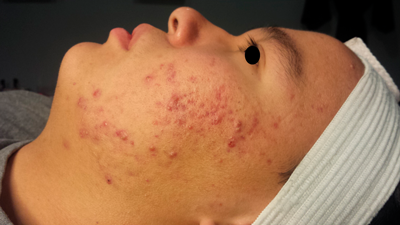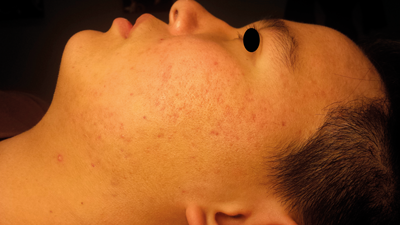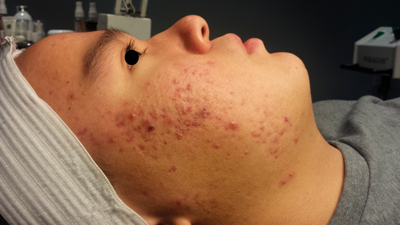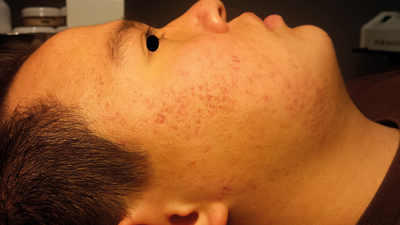The complexity of acne stems both from its pathogenesis that involves a series of events, including follicular hyperconification, increased sebum production, colonisation of Propionibacterium (P) acnes, and inflammation [1] and its range of symptoms that are unique to each individual.
In this particular case, a 16-year-old male presented with a moderate case of acne in the form of blackheads and whiteheads, as well as inflamed papules and pustules located mostly on his cheeks. Attempts at resolving his acne were unsuccessful until he completed a series of light-emitting diodes (LED) treatments, which is sometimes referred to as low-level light therapy (LLLT). He was advised to use an organic cleanser twice daily, change his pillowcase every third day and he received two LED treatments per week for eight weeks with 48 hours in between sessions.

Figure 1: The left side of the face before treatment.

Figure 2: The left side of the face after treatment.

Figure 3: The right side of the face before treatment.

Figure 4: The right side of the face after treatment.
This programme is relatively straightforward given the dramatic resolution demonstrated in this case. The recommendations did not include a complicated skincare regimen, topical or oral medication, chemical peels or lasers. Social downtime and possible side-effects of typical acne treatments were all minimal. Not all LED devices are capable of dealing with this condition; specific parameters should be followed in order to produce effective results.
According to Dr Daniel Barolet (2008), “The question is no longer whether it (LED) has biological effects, but rather what the optimal light parameters are for different uses” [2]. Biological effects depend on the parameters of the irradiation such as wavelength, dose intensity, irradiation time, continuous wave or pulsed mode, and for the latter, pulsing patterns [1]. In other words, the specific wavelengths, the energy delivered, modulation, treatment time, as well as the proximity to the skin, are all factors that will collectively determine if a therapeutic result is possible. Here are the LED parameters and steps taken in this clinical case:
- Thoroughly cleanse the skin:
It’s imperative that the skin is clean, dry and free of any reflective substances, since any barrier between the lights and the skin will inhibit light absorption. - Position the light therapy device as close to the skin as possible:
Using a flexible LED panel that can be moulded around the natural curves of any skin surface is crucial in reducing the space between the lights and the skin. - Choose proper wavelength(s):
blue dominant light with red and near infrared: A polychromatic LED device (that allows multiple wavelengths to run simultaneously) will allow the blue light (shorter wavelength – 465nm) to kill the P. acnes bacteria, the red light (a little longer – 645nm) to knock down the inflammatory response and the near infrared light (even longer – 880nm) to increase microcirculation for a healing response, all at the same time. - Have the patient relax under the lights for 30 minutes:
Treatment time is dependent on the amount of energy delivery. The clinical data supports a 30-minute session for the hands-free device used in this case, but timing will vary based on the device. - Apply appropriate skin care products:
Moisturise and protect the skin after the treatment is complete.
Acne concerns, including excess sebum production, P. acnes bacteria, inflammation, redness, pain and scarring may potentially be treated with LED light therapy. This may provide a simple, effective, timely and comfortable resolution to the problem.
References
1. Lee SY, You CE, Park MY. Blue and red light combination LED phototherapy for acne vulgaris in patients with skin phototype IV. Lasers Surg Med 2007;39:180-8.
2. Barolet, D. Light-Emitting Diodes (LEDs) in Dermatology. Lasers Surg Med 2008;27: 227-38.
Declaration of competing interests: The author is an Aesthetic Educator for Celluma Light Therapy.
COMMENTS ARE WELCOME





